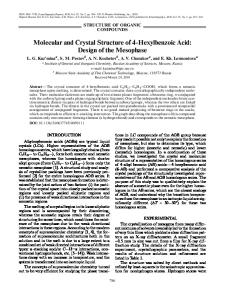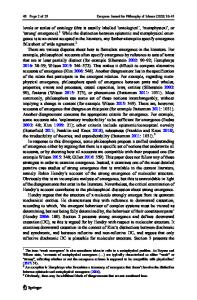Crystal structure of the molecular complex of 3-[1-(4-nitrophenyl)-3-oxobutyl]-4-hydroxychromen-2-one with ethanol
- PDF / 236,811 Bytes
- 4 Pages / 612 x 792 pts (letter) Page_size
- 4 Downloads / 244 Views
URE OF ORGANIC COMPOUNDS
Crystal Structure of the Molecular Complex of 3-[1-(4-Nitrophenyl)-3-Oxobutyl]-4-Hydroxychromen-2-one with Ethanol A. N. Kochetova and L. G. Kuz’minab a
Lomonosov State Academy of Fine Chemical Technology, pr. Vernadskogo 86, Moscow, 119571 Russia e-mail: [email protected] b Kurnakov Institute of General and Inorganic Chemistry, Russian Academy of Sciences, Leninskiœ pr. 31, Moscow, 119991 Russia Received December 28, 2006
Abstract—The crystal structure of 2,3H-2-methyl-4-(4-nitrophenyl)-5-oxobenzopyrano[3,4-e]dihydropyran2-ol is investigated using X-ray diffraction. The unit cell contains an ethanol molecule that forms hydrogen bonds with O–H and C=O groups of two molecules of the main compound and acts as a proton donor and a proton acceptor in these hydrogen bonds. Owing to these interactions, infinite chains are formed in the crystal. The crystallographic data for the structure of C19H15NO6 · C2H5OH (M = 399.39) are as follows: the crystals are triclinic, space group P1, a = 5.5340(3) Å, b = 8.0109(4) Å, c = 11.0112(5) Å, α = 88.773(2)°, β = 84.788(2)°, γ = 79.958(2)°, and Z = 1. PACS numbers: 61.66.Hq DOI: 10.1134/S1063774507040141
INTRODUCTION 3-[1-(4-Nitrophenyl)-3-oxobutyl]-4-hydroxychromen2-one, which is known under the trademark Syncoumar, and other 4-hydroxycoumarins substituted in the 3-position are widely used as blood anticoagulants in medicinal practice [1, 2]. The anticoagulant activity is shown by individual compounds [1–3], their salts with alkali metals [2, 4, 5], and molecular complexes with alcohols [5, 6]. The mechanism of this activity has not been adequately studied, although attempts to solve this problem were made in [7–9]. Earlier, the biological activity of 4-hydroxycoumarin derivatives was attributed to their ability to form strong intramolecular hydrogen bonds [10] and to inhibit the synthesis of vitamin K dependent factors of hemostasis. More recently, it was found that these compounds are characterized by ring-chain tautomerism [4, 11–14] and that the highest activity is shown by the open-chain form of a particular spatial configuration [15]. In the crystal state, however, the compounds under consideration exist only in a semiketal form [12, 16–19].
reverse situation is observed for the activity of the corresponding isomers of the Syncoumar under investigation [21, 22]. In contrast to other 4-hydroxycoumarin derivatives, namely, the related drugs Warfarin [12, 16– 19] and Phepromaron [23, 24], structural studies of the pharmacopoeial drug Syncoumar in the crystal state have not been performed. Interest in the structural details has been motivated by the data available in the literature on the large number of polymorphic modifications of these compounds [25, 26]. Investigations of polymorphic modifications in different classes of medicines have revealed significant differences in the pharmacokinetics of particular polymorphic modifications [27]. The structure of the molecular complex of Syncoumar with ethanol has been investigated. Such compounds of anticoag
Data Loading...











